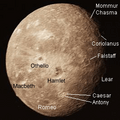Oberon (moon) facts for kids
Oberon is the farthest large moon of the planet Uranus. It is made of about half ice and half rock.
Oberon is about 760 km (472 mi) wide. This makes it the second biggest of Uranus's 27 moons. It travels around Uranus about every 13.4 days.
William Herschel discovered Oberon on January 11, 1787. In the same year, he also found Titania, another moon of Uranus. Oberon was named after the King of the Fairies, a character from William Shakespeare's play A Midsummer Night's Dream.
Oberon has many large craters. These are big holes made when meteorites crashed into its surface. The Voyager 2 spacecraft took pictures of these craters in 1986 when it flew past the moon. Scientists also think there might be a mountain on Oberon that is about 20 km (12 mi) high.
Surface Features of Oberon
The craters and other features on Oberon are named after characters from the plays of William Shakespeare.
| Feature Name | Named After | Type of Feature | Size (diameter), km | Location |
|---|---|---|---|---|
| Mommur Chasma | Mommur, from French stories | Chasma (a deep, long valley) | 537 | 16°18′S 323°30′E / 16.3°S 323.5°E |
| Antony | Mark Antony | Crater (a round hole) | 47 | 27°30′S 65°24′E / 27.5°S 65.4°E |
| Caesar | Julius Caesar | 76 | 26°36′S 61°06′E / 26.6°S 61.1°E | |
| Coriolanus | Coriolanus | 120 | 11°24′S 345°12′E / 11.4°S 345.2°E | |
| Falstaff | Falstaff | 124 | 22°06′S 19°00′E / 22.1°S 19.0°E | |
| Hamlet | Hamlet | 206 | 46°06′S 44°24′E / 46.1°S 44.4°E | |
| Lear | King Lear | 126 | 5°24′S 31°30′E / 5.4°S 31.5°E | |
| MacBeth | Macbeth | 203 | 58°24′S 112°30′E / 58.4°S 112.5°E | |
| Othello | Othello | 114 | 66°00′S 42°54′E / 66.0°S 42.9°E | |
| Romeo | Romeo | 159 | 28°42′S 89°24′E / 28.7°S 89.4°E |
Images for kids
See also
 In Spanish: Oberón (satélite) para niños
In Spanish: Oberón (satélite) para niños




